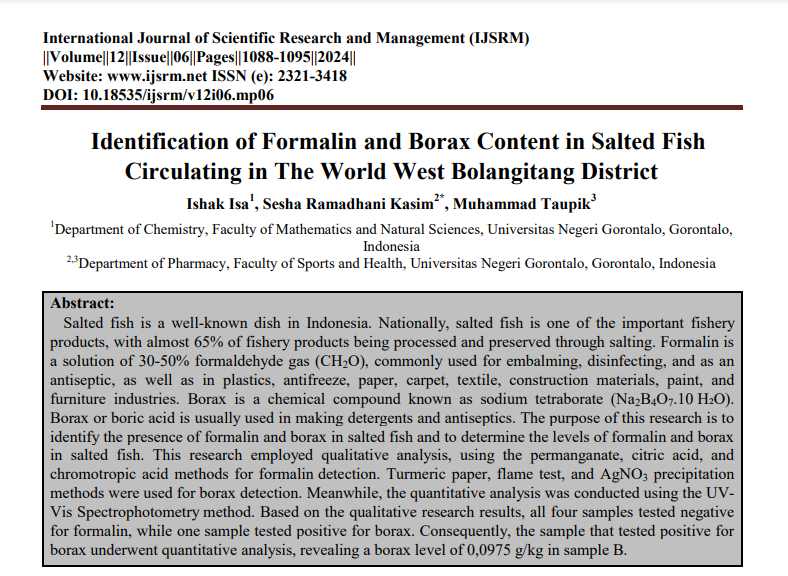Identification of Formalin and Borax Content in Salted Fish Circulating in The World West Bolangitang District

Submission to VIJ 2024-10-04
Keywords
- Borax,
- Formalin,
- Salted Fish,
- UV-Vis Spectrophotometry
Copyright (c) 2024 Ishak Isa, Sesha Ramadhani Kasim, Muhammad Taupik

This work is licensed under a Creative Commons Attribution 4.0 International License.
Abstract
Salted fish is a well-known dish in Indonesia. Nationally, salted fish is one of the important fishery products, with almost 65% of fishery products being processed and preserved through salting. Formalin is a solution of 30-50% formaldehyde gas (CH2O), commonly used for embalming, disinfecting, and as an antiseptic, as well as in plastics, antifreeze, paper, carpet, textile, construction materials, paint, and furniture industries. Borax is a chemical compound known as sodium tetraborate (Na2B4O7.10 H₂O). Borax or boric acid is usually used in making detergents and antiseptics. The purpose of this research is to identify the presence of formalin and borax in salted fish and to determine the levels of formalin and borax in salted fish. This research employed qualitative analysis, using the permanganate, citric acid, and chromotropic acid methods for formalin detection. Turmeric paper, flame test, and AgNO3 precipitation methods were used for borax detection. Meanwhile, the quantitative analysis was conducted using the UV-Vis Spectrophotometry method. Based on the qualitative research results, all four samples tested negative for formalin, while one sample tested positive for borax. Consequently, the sample that tested positive for borax underwent quantitative analysis, revealing a borax level of 0,0975 g/kg in sample B.
References
- S. Fatimah, D.W. Astuti, N.H. Awalia, “Analisis Formalin pada Ikan Asin di Pasar Giwangan dan Pasar Beringharjo Yogyakarta,” Analit: Analytical and Environmental Chemistry, 2017.
- D. Lestari, M. Dewi, S.C. Ningsih, H. Hidayati, “Identifikasi Boraks Pada Pentol Bakso di Kelurahan Air Hitam Dengan Pereaksi Kulit Buah Naga Merah (Hylocereus polyhizus),” Jurnal Riset Kefarmasian Indonesia, III (1), pp. 58-64, 2021.
- I. Mudzikirah, “Identifikasi Penggunaan Zat Pengawet Boraks dan Formalin pada Makanan Jajanan di Kantin UIN Alauddin Makassar Tahun 2016,” IOSR Journal of Economics and Finance, III, 2016.
- E.F. Rahmadani, Deteksi Daging Ayam Yang Diformalin Secara Visual, Organoleptik, Kimia dan Fisika, PhD Thesis, Universitas Sumatera Utara, 2008.
- M.G. Subiyakto, Bakso Boraks dan Bleng, PT. Gramedia, Jakarta, 1991.
- H. Maâ, M.S. Sangi, A.D. Wuntu, “Analisis Kandungan Formalin dan Boraks pada Ikan Asin dan Tahu dari Pasar Pinasungkulan Manado dan Pasar Beriman Tomohon,” Jurnal Mipa, VI (2), pp. 24-28, 2017.
- I.M. Siaka, “Analisis bahan pengawet benzoat pada saos tomat yang beredar di wilayah Kota Denpasar,” Jurnal Kimia, III (2), pp. 87-92, 2009.
- L. Mylene, T. Hajija, “Analisis Kadar Boraks Pada Tahu Putih yang di Produksi dengan Menggunakan Spektrofotometri UV-Vis,” Jurnal Riset Rumpun Ilmu Kedokteran, I (1), pp. 20-27, 2022.
- T. Aryani, A.B. Widyantara, “Analisis Kandungan Boraks Pada Makanan Olahan Yang Dipasarkan Di Sekitar Kampus,” Jurnal Riset Kesehatan, VII (2), pp. 106-109, 2018.
- I.G. Gandjar, A. Rohman, Kimia Farmasi Analisis, Pustaka Pelajar, Yogyakarta, 2007.
- M.N. Seran, S. Sio, K.W. Kia, ”Deteksi Kandungan Formalin dan Boraks pada Bakso Daging yang Dijual Di Kota Kefamenanu,” Journal of Animal Science, VI (3), pp. 52-55, 2021.
- L.K. Muharrami, “Analisis Kualitatif Kandungan Boraks Pada Krupuk Puli Di Kecamatan Kamal,” Jurnal Pena Sains, II (2), 2015.
- N.S. Wijayanti, M. Lukitasari, “Analisis Kandungan Formalin dan Uji Organoleptik Ikan Asin yang Beredar di Pasar Besar Madiun,” Florea: Jurnal Biologi Dan Pembelajarannya, III (1), pp. 59-64, 2016.
- L. Sa’adah, Identifikasi Boraks dan Asam Borat pada Beberapa Jenis Mie yang Diperoleh dari Pasar Depok, Skripsi, Universitas Indonesia, 2006.
- N. Ayuchecaria, A.K. Sari, E. Fatmawati, ”Analisis Kualitatif Formalin Pada Ayam Yang Dijual Di Pasar Lama Wilayah Banjarmasin,” Jurnal Ilmiah Ibnu Sina, II (1), pp. 51-59, 2017.